Case Study: US Olympic Gymnastics Study Using Polhemus Tracking Technology
The purpose of this study was to provide some preliminary information on the vault board. These initial results are part of a much larger ongoing study of the behaviors of gymnastics apparatuses. The Polhemus LIBERTY was used for the precision motion measurement that was necessary.
Wm A. Sands, Ph.D., Head – Sport Biomechanics and Engineering, U.S. Olympic Committee
Sarah L. Smith, Ph.D., Senior Biomechanist, U.S. Olympic Committee
Thomas Piacentini, Intern, Sport Biomechanics and Engineering
The vault board is used for vaulting take-offs, drills and skills for tumbling and vaulting, and other apparatus mounts. It has undergone a limited amount of scrutiny with regard to its behavior. However, the interaction of the vault board with gymnasts has scarcely been addressed. The following information is largely descriptive and meant to portray vault board movement behaviors during vaulting take-offs and our current preliminary efforts at studying the vault board.
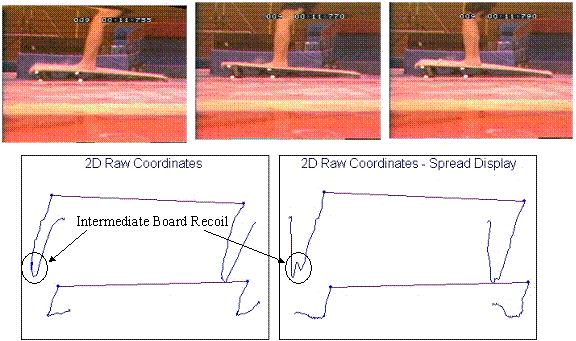
Vault board behavior was analyzed by two primary means: high-speed video and magnetic motion tracking. Video analyses of vault board behavior were undertaken using high-speed video (NAC HSV 400) at 200 frames per second. Four reflective markers were placed on the board as shown in Figure 1. The reflective markers were video taped and then rendered to x-y coordinates (two-dimensional analyses) via Peak Performance Technologies software.
The raw data were analyzed for position, displacement, and velocity information. Figure 1 shows the vault board response that occurred when a young male gymnast performed a handspring vault over a vault table. Note that the response of the board indicated an intermediate recoil and a complex wave-like movement of the upper surface of the board that resulted in tipping of the board from side-to-side, as well as a whipping movement of the most forward board marker.
Figure 1: Note the white markers attached to the side edge of the vault board. These markers permit automatic digitizing of the vault board movements during a take-off impact. Note that the impact resulted in a side-to-side tipping of the vault board and a fore-aft complex wave-like motion. The graphic depictions below the photos show the traced movements of the four markers. The upper-left marker that corresponds to the top forward corner of the vault board shows an intermediate recoil. The 2D Raw Coordinates Spread Display plots each point while moving the image sequentially to the right to prevent marker positions from being drawn on top of each other. The Spread Display shows most clearly the intermediate recoil of the upper-left marker of the vault board.
In addition to the high-speed video of the vault board movement, later work has taken advantage of a magnetic motion tracking system. The LIBERTY™ magnetic motion tracking system was provided by Polhemus; the software was provided by Advanced Motion Measurement, LLC. Eight magnetic sensors were taped rigidly to the side edge of the top and bottom surfaces of the vault board.
These sensors provide six degrees of freedom sensing which means that the sensors are able to record positions in x, y, and z planes; the sensors also provide angular position and displacement information in a roll, pitch, and azmuth type format. These sensors provide sub-millimeter precision and sample at 240 Hz.
The precision was so great that the gymnast's last few running steps were detected by the sensors due to the deformation of the wooden gymnasium floor as the gymnast approached. Figure 2 shows the sensor configuration.
The magnetic motion tracking system is important due to the issue of the vault safety mat that will be used for Yurchenko-type vaults. Reflective video makers will be obscured by the safety mat making the detection of board motion impossible by traditional video means (Figure 3).
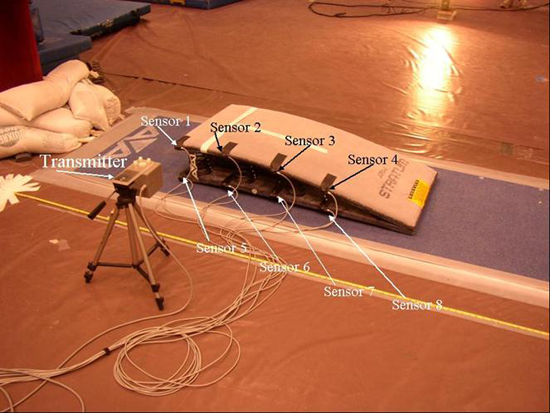 Figure 2: Magnetic sensors are shown taped to the side edge of a vault board's upper and lower surfaces. Note the transmitter for the magnetic sensors is shown on the tripod to the left of the vault board. The magnetic field created by the transmitter is sensed and the relative positions of the sensors are recorded by a laptop computer.
Figure 2: Magnetic sensors are shown taped to the side edge of a vault board's upper and lower surfaces. Note the transmitter for the magnetic sensors is shown on the tripod to the left of the vault board. The magnetic field created by the transmitter is sensed and the relative positions of the sensors are recorded by a laptop computer.
An example of the type of data provided by the magnetic sensors is shown in Figures 4 and 5.
Both figures show screen images of the Advanced Motion Measurement software with the sensor triads depicted along with a graph of the Z direction (up and down) sensor positions for six of the eight sensors. Figure 4 shows the results of a take-off on one type of vault board.
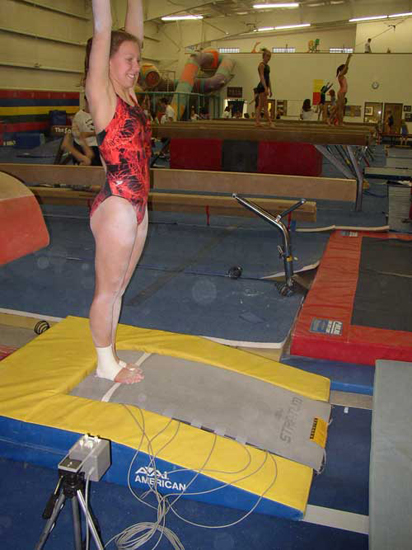 Figure 3: Image with gymnast shows the vault board is shown with the safety mat surrounding the board on three sides. An example of the type of data provided by the magnetic sensors is shown in Figures 4 and 5. Both figures show screen images of the Advanced Motion Measurement software with the sensor triads depicted along with a graph of the Z direction (up and down) sensor positions for six of the eight sensors. Figure 4 shows the results of a take-off on one type of vault board.
Figure 3: Image with gymnast shows the vault board is shown with the safety mat surrounding the board on three sides. An example of the type of data provided by the magnetic sensors is shown in Figures 4 and 5. Both figures show screen images of the Advanced Motion Measurement software with the sensor triads depicted along with a graph of the Z direction (up and down) sensor positions for six of the eight sensors. Figure 4 shows the results of a take-off on one type of vault board.
Figure 4: Sensor configuration and sensor movement are shown above. The graph shows the movement of sensors 1 through 6. Note that the take-off from this board presented an intermediate recoil that occurred during the initial descent of the magnetic sensors during the initial impact of the gymnast onto the vault board.
Figure 5 shows the movement of the sensors on a different type of vault board. Note that the take-off from this board does not show an intermediate recoil. Figures 4 and 5 were the result of the same athlete performing the same handspring vault. Sensor configuration and movements (see graph) are shown in the Figure 5 screenshot.
Figure 6 shows the vault board response for a Yurchenko vault. The Yurchenko vault take-off from the vault board is usually performed with a take-off impact much closer to the higher end of the board (i.e. closer to the vault table).
This type of take-off is performed after a round off which serves to turn the gymnast 180 degrees from his or her run; thus the athlete is facing backward when contacting the board.
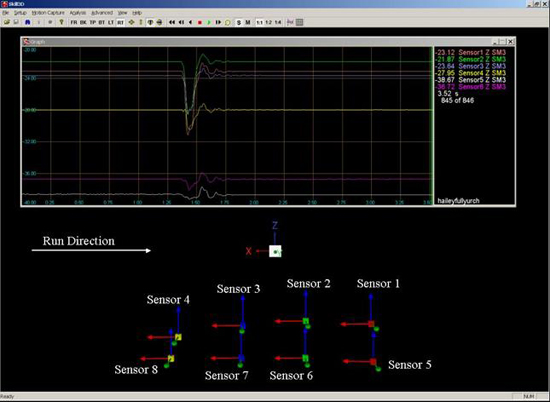
Figure 6. Yurchenko take-off. Note that the vault board movements are more subtle and displacement patterns show that the gymnast's take-off has a more prolonged contact time with the board.
To conclude this initial discussion of vault board behavior, Figures 7 and 8 display the vault board recoil patterns as depicted by the sensors. Note that the recoil movements of the two measured vault boards are quite different for the same type of vault performed by the same gymnast. One of the boards (Figure 7) shows the sensors rising almost directly vertical. Figure 8 shows the sensors rising vertically initially and then move obliquely backward. At present, whether one movement is superior to the other is unknown.
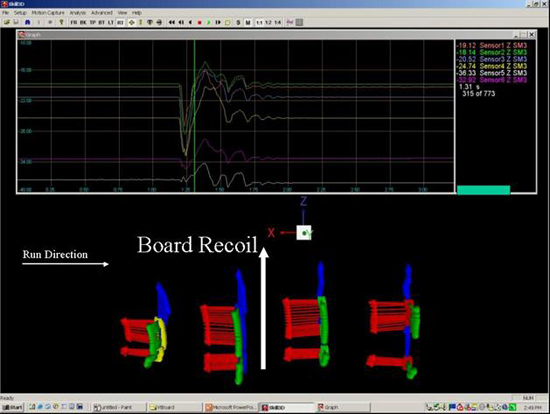
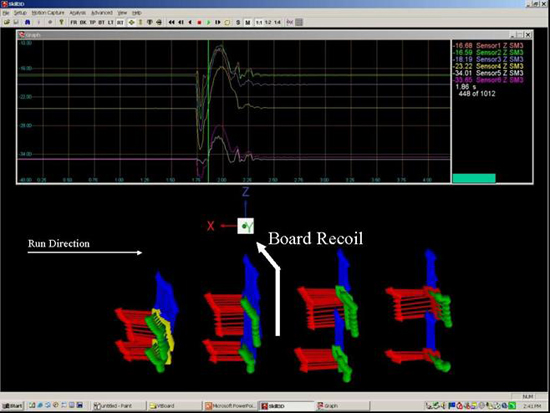
Figure 7. Vertical recoil actions of one type of vault board. Note that the sensors rise almost directly vertical during recoil.
Figure 8: Note that the triads move vertically during the early phase of the major board recoil, but then the triads move rearward and upward during the latter phase of the recoil.
Figure 9 shows the displacement of sensors during a Yurchenko vault take-off in a multi-image format. Note that the forward-end (rightmost) of the board (Sensor 1) is deflecting the farthest and this corresponds to the take-off impact striking the forward end of the board.
This deflection pattern is in marked contrast to the typical type of impact pattern that is observed when gymnasts perform a handspring type vault where board contact occurs nearer the rear or leftmost part of the board (e.g., sensors 3 and 4).
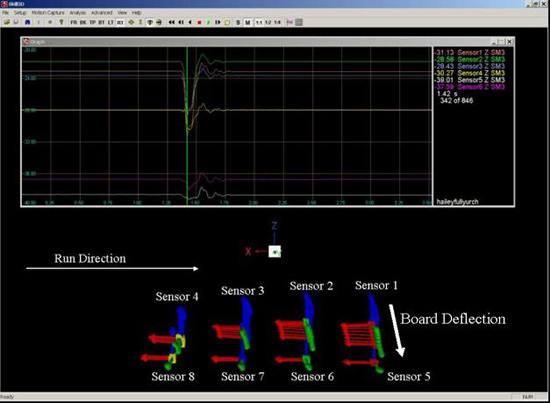
Figure 9: Yurchenko vault, initial impact. Note that Sensor 1 is descending farther and more rapidly than the remaining sensors. This indicates the position of the feet where the gymnast contacted the board.
Conclusion
This preliminary report has shown that the two types of vault boards analyzed thus far behave differently. Moreover, it was shown that individual athletes often have markedly different impact signatures with regard to vault board movements.
In order to determine if these differences in both athlete and vault board behaviors are good or bad, further analyses will be necessary. Moreover, the results indicated that the board actions, gymnasts' impressions of these actions, and resulting take-off actions are often counter-intuitive and may defy conventional coaching wisdom. These analysis techniques will be applied to the floor exercise apparatuses and balance beams. The capabilities of these measurement techniques look very promising.
Learn More:
- LIBERTY
- Download PDF
- Contact sales@polhemus.com
Reference List
Fie, J. (1984). Synthetic boards spring past wood. Technique, 4(1), 12-13,19.
Greenwood, M., & Newton, J. W. (1996). Direct force measurement of the vault take-off in gymnastics. J. M. C. S. Abrantes Proceedings XIV International Symposium on Biomechanics in Sports (pp. 332-334). Lisbon, Portugal: Edicoes FMH Universidade Tecnica de Lisbon.
Sano, S., Ikegami, Y., Nunome, H., Apriantoni, T., & Sakurai, S. (2004). An accurate estimation of the springboard reaction force in vaulting table of gymnastics. Proceedings of XXII International Symposium of Biomechanics in Sports University of Ottawa, Ottawa, Canada: Faculty of Health Sciences, University of Ottawa, Ottawa, Canada.

